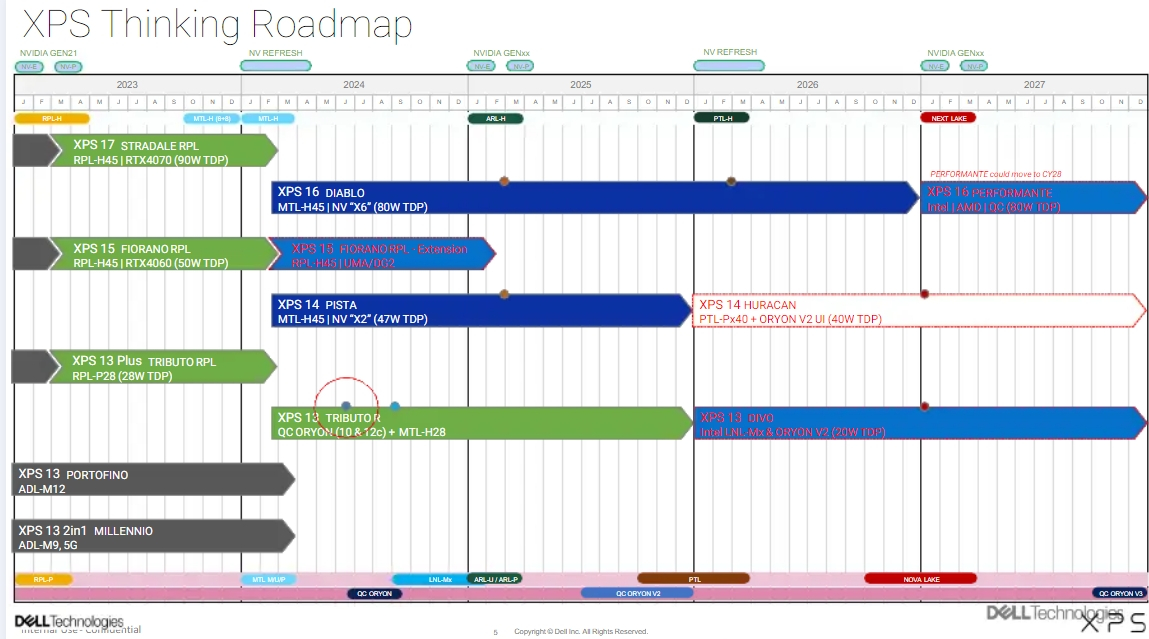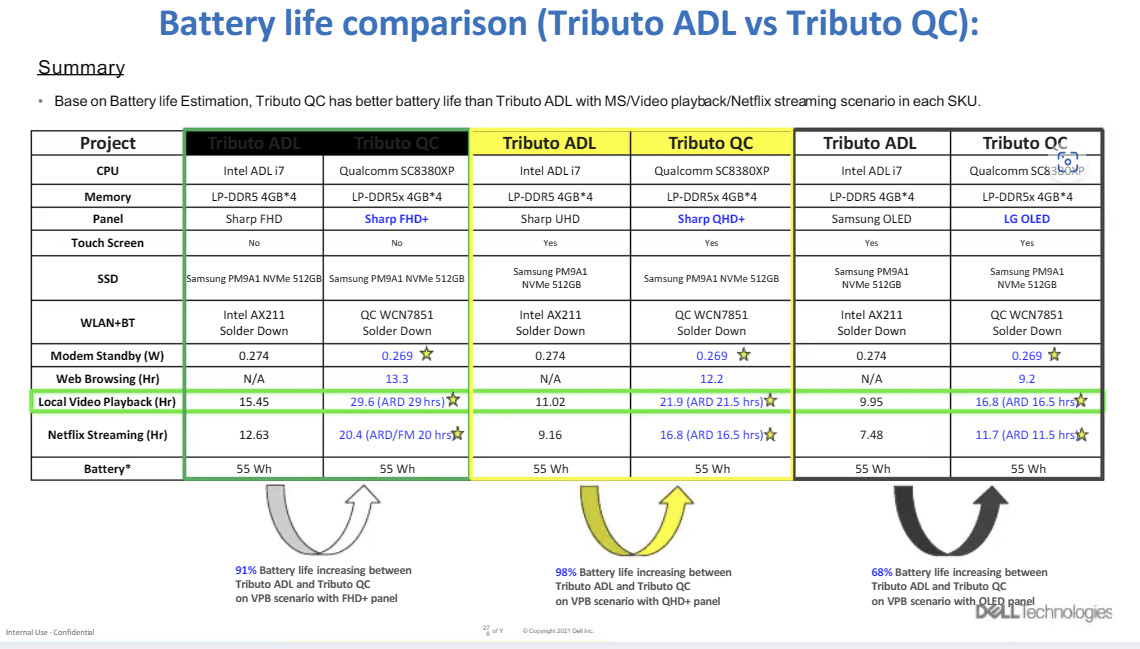Just a few days after renders of Dell’s upcoming Snapdragon X Elite laptops—including an XPS 9345 and Dell Inspiron 7441—leaked, Videocardz got its hands on a massive Dell XPS roadmap leak with some tasty information about Qualcomm’s plans for the future of Snapdragon X.
The 311-page leaked roadmap includes tidbits about next-gen Qualcomm Snapdragon X chips and information about new XPS laptops powered by the first Snapdragon X platform, which we expect to be announced in the coming weeks.
Qualcomm Snapdragon “Oryon V2” and “Oryon V3”
An “XPS Thinking Roadmap” slide from the leaked report on Scribd lists QC Oryon (QC stands for Qualcomm) as set to arrive with the XPS 13 Plus in 2024. It also lists a “QC Oryon V2” expected for the second half of 2025 and a “QC Oryon V3” towards the end of 2027.
Oryon is the name of the processor (CPU) used in the Snapdragon X Elite and Snapdragon X Plus Systems-in-Chip (SoC), joined by an Adreno-integrated GPU and a Hexagon Neural Processing Unit (NPU).
Beyond the V2 and V3 names, not much is known about Qualcomm’s plans for the future of Snapdragon X. It is not, however, much of a surprise that Qualcomm plans on improving its Snapdragon X chips with generational updates. With a relatively quick turnaround for the Oryon V2 and a longer gap for the Oryon V3, it might suggest that Qualcomm plans on more significant rework for 2027.
Turning back to the ARM-powered XPS 13 expected this year, it looks like it will be available with the 10-core Snapdragon X Plus and 12-core X Elite chips. Dell lists 17.5W and 25.5W maximum TDPs, with a 20+ hour target for battery life while video streaming.
In a comparison chart, Dell shows the Qualcomm-powered XPS 13 Plus as hitting up to 21.9 hours of video playback with a QHD+ display, up 98% compared to Intel’s 12th Gen Alder Lake Core i7 chip. In an otherwise similar comparison, battery life improvements drop to 68% when using an OLED display. Of course, this is also not a completely fair comparison, as Intel has made improvements in efficiency with its newer CPUs.
As for other listed specs, the ARM-powered XPS 13 Plus will come with up to a 2.8K OLED touch display, a 1080p webcam, LPDDR5x-8400 RAM support, and something called Qualcomm Fluence Audio. It will not offer 5G connectivity, but Wi-Fi 7 support is included.
This XPS 13 news aligns with a host of Snapdragon X laptops expected to be announced later this month and in June. It also coincides with Microsoft’s May 20 event, at which it is expected to unveil new ARM-powered Surface PCs and Windows AI features.
Dell’s plans for the XPS brand
Dell’s roadmap provides some interesting information about the future of the XPS brand. Its XPS 13 Plus (codenamed Tributo R), powered by Snapdragon X Elite and X Plus chips, is expected to be officially announced very soon. It will ride alongside models with Intel Core Ultra Meteor Lake chips.
The XPS 14 (currently codenamed Pista), which uses Intel’s Core Ultra CPUs, looks like it will receive a performance bump to Intel Arrow Lake CPUs and next-gen NVIDIA GPUs in 2025. In 2026, it will receive a more serious overhaul (with a new “Huracan” codename), sporting Intel’s next-gen Panther Lake CPUs and Qualcomm’s Oryon V2 chips. Dell has these laptops pegged at a 40W TDP.
A new XPS 13 model (codenamed Divo) is also expected at the beginning of 2026. The roadmap lists it as using Intel Lunar Lake CPUs and Qualcomm’s Oryon V2 chips, with Dell listing them at a 20W TDP.
The current XPS 16 (codenamed Diablo) that uses Intel’s Meteor Lake CPUs is expected to receive a refresh in 2025 for Intel’s Arrow Lake chips and new NVIDIA GPUs, with another update in 2026 for Intel Panther Lake. Dell has 2027 as a big year for the XPS 16, with a new “Performante” codename signaling a more significant refresh. Intel, AMD, and Qualcomm are all listed, with an 80W TDP target.
It’s interesting to note that Dell plans to phase out the XPS 15 by the start of 2025. That’s not a huge surprise, with the new XPS 14 and XPS 16 models taking over to offer extra performance from discrete graphics and more powerful CPUs.
As with all leaks, the information should be approached with caution. However, this document has all the makings of a genuine internal report. It’s also worth noting that roadmaps don’t always work out as planned. Only time will tell, but the info here helps back up Qualcomm’s claims about efficiency from its new Snapdragon X chips.








